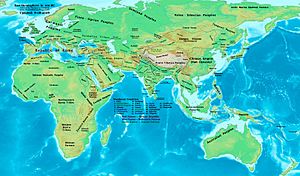Aorsi facts for kids
The Aorsi were an ancient group of people. They were part of the Sarmatians, who were an Iranian group. The Aorsi were very important in the area around the Black Sea and Caspian Sea. This was from about 100 BC to 100 AD.
Many people think the Aorsi are connected to a state called Yancai. This state is mentioned in old Chinese records. The Alans are another group. They are often seen as the people who came after the Aorsi. The Alans were first written about by scholars in the 1st century AD.
Contents
What's in a Name?
The name Aorsi is thought to come from old words meaning 'white'. For example, in the Avestan language, the word auruša- means white. In the Ossetic language, ūrs or ors also means white. Some old names like Arsīyah and Arsā might also be related. These names were mentioned by writers in the 10th to 12th centuries AD.
Aorsi History
The Aorsi and a related tribe, the Siraces, likely moved from Central Asia. This happened in the late 5th century BC. They settled in areas north and west of the Caspian Sea. The Aorsi's land may have reached as far east as the Aral Sea.
Aorsi and Strabo
A very important writer about the Aorsi was Strabo. He was a Greek geographer. He wrote a book called Geographica around 24 AD. Strabo said the Aorsi lived north-east of the Siraces. The Siraces lived between the Lake Maeotis (now the Sea of Azov) and the Caspian Sea.
The "Upper Aorsi" lived furthest to the east. They had the largest territory. Strabo said they controlled the Caspian coast. This helped them become the strongest group. The Upper Aorsi brought goods from India and Babylonia. They used camels and traveled through Armenia and Media. This trade made them very rich. They controlled the northern part of the Silk Route. The Aorsi were also known for wearing beautiful golden jewelry.
Aorsi in War
During the time of Pharnaces II, a king of the Bosporan Kingdom, the Aorsi were very powerful. Strabo wrote that King Spadines of the Aorsi, who lived near the Don River, could gather 200,000 horsemen for battle. The Upper Aorsi could gather even more.
In 49 AD, there was a war in the Bosporan Kingdom. The Roman writer Tacitus wrote about it in his book Annals. King Eunones of the Aorsi supported the side that was friendly to Rome. This was Tiberius Julius Cotys I. But King Zorsines of the Siraces supported the side against Rome. This was Tiberius Julius Mithridates.
The Aorsi, along with Roman soldiers, attacked a town of the Siraces. They defeated the people there. This made King Zorsines give up and bow down to a statue of the Roman Emperor Claudius.
Mithridates gave up to Eunones. Eunones felt bad for Mithridates. He asked Emperor Claudius to spare Mithridates' life. Claudius agreed. Mithridates was not killed. Instead, he was sent away to live somewhere else. After this war, the Siraces became much weaker. The Aorsi, however, became stronger.
Aorsi, Yancai, and Alans
Many experts believe the Aorsi and the Alans are the same as the state of Yancai. Yancai was also known as Alanliao. These names are found in older Chinese records.
Chinese Records
In the 2nd century BC, a diplomat named Zhang Qian wrote about Yancai. He said Yancai was about 832 kilometers (517 miles) north-west of a state called Kangju. Yancai was near the Aral Sea. Its people could gather 100,000 horse archers. This location on the Eurasian Steppe is similar to where Strabo said the Aorsi lived.
Later, a Chinese book called the Hou Hanshu (written in the 5th century) mentioned Yancai again. It said Yancai had become a smaller state under Kangju. It was then called Alanliao.
Migration and Alans
Y. A. Zadneprovskiy thinks that Kangju took control of Yancai in the 1st century BC. Kangju's expansion to the west made many Aorsi and other Sarmatians move further west. This movement of people was a big part of the Migration Period in Europe. This period changed world history a lot.
In the 1st century AD, the Alans became very powerful. They were a group from the east. They were closely related to the Aorsi. The Alans either joined with the Aorsi or took them over. Some Aorsi people seem to have moved west. They went north of Crimea and lived there semi-independently. The writer Ptolemy even mentioned "Alanorsi." This suggests that the Alans and Aorsi had somehow joined together.
See Also
 In Spanish: Aorsos para niños
In Spanish: Aorsos para niños
- List of ancient Iranian peoples
- Arsiyah
- Erzya, Aorsi and Arsiyah


